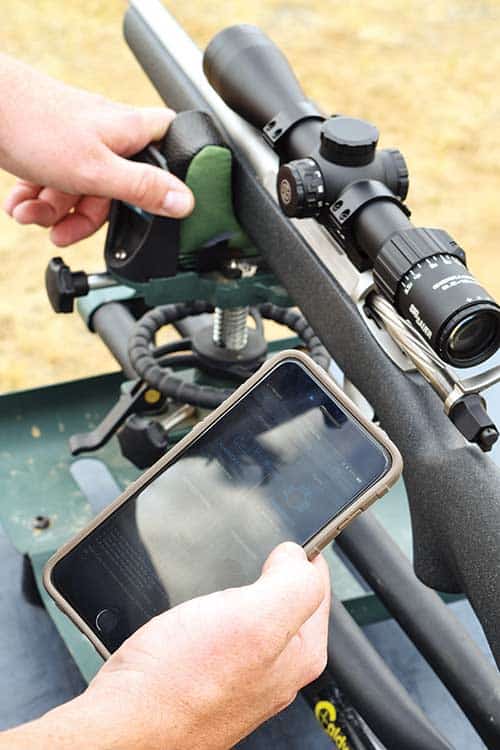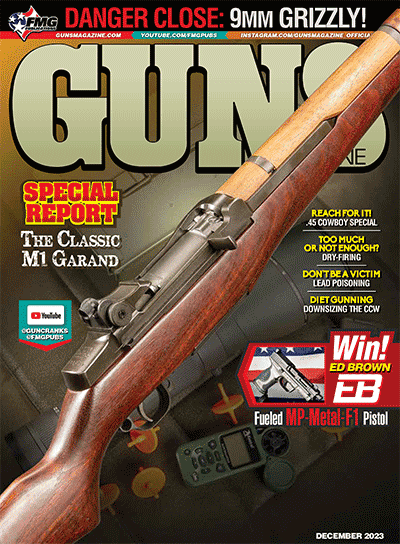Optical Technology Marches On
Tomorrow Is Really Today!
Digits above the red dot drifted up into the corner of the screen: 496 yards. Incline of 11 degrees; 8 degrees tilt. The data would be updated 54 times a second by three gyroscopes and seven processors.
Neither a computer game nor a missile guidance system, this wizardry perched atop a .30-06 bolt rifle to help me aim. It was called Tracking Point 2020 — and it’s now 10 years old.
Digital Revolution
Headquartered in Austin, Texas, TrackingPoint partnered with Remington on the project, pairing the futuristic sight with Model 700 bolt rifles in .30-06 and .308, and with a Bushmaster AR-15 in .223.
During my shop tour, CEO Jason Schauble rattled off a litany of Silicon Valley acronyms. Circuit boards and cubicles bounced color from jumpy computer screens. As in other rifle-scope factories, TrackingPoint CNC machines chiseled scope tubes from high-grade alloy. Optical glass came next. But the beating heart of each unit was digital.
A TrackingPoint sight not only read distance and conditions — it compensated for them. After a target was “tagged” by the shooter, the reticle adjusted if it moved. If the rifle moved, TrackingPoint registered when it came back on target. Given steady pressure on the trigger, a shot would go only when the sight was properly aligned.
I peered into the heads-up display (HUD) of the TP on a .30-06. It showed time, date, barometric pressure, temperature and a compass reading. Ehren coached me through the procedure. “Target registry, or tracking, can be lost by a quick change in rifle position — as it is by recoil — so you’re smart to tag the target just before firing. If the range read goes away, you start over.” When the white dot turns red, the target is registered. Put the blue X reticle on the dot. When the X turns red, the rifle is on target for a center hit.
Soon thereafter, in a steamy Texas dawn, I leveled a TrackingPoint-equipped .308 on a red deer easing from a brushy wash. When the blue X turned red behind his foreleg, a 150-grain Core-Lokt sped away. I lost the stag in recoil. He lay 20 steps beyond the strike; my bullet having minced his lungs and clipped the top of his heart. The target image had been clear enough, though not nearly as sharp as in an ordinary scope. The evening before, I had found TP images faded an hour before shooting light expired. Another mark against the TrackingPoint was its weight: a hefty 52 oz. Two big batteries contributed.
Remington’s TP package rifles didn’t sell well and TrackingPoint stopped taking orders in 2014. With a reduced staff, the company produced costlier versions of its sights, mainly for “tactical” use. It had all but vanished from the civilian market when in 2018 it sold to Talon Precision Optics. Traditionalists took little note; we were quite happy with rifle-scopes from the 1960s.
No Stopping Now
But the digital genie was out of the bottle. He has since become a constant presence. At times, as in the case of Swarovski’s dS scope, “digital intelligence” has been paired with the bright, crisp images of the best optical glass. The 5-25×52 dS, a 38-oz. scope introduced at the 2019 SHOT show, is a feature-laden 40mm sight with HUD showing ballistic data relevant to each shot, while an aiming point on the reticle lights up for dead-on hold whatever the range.
BDX scopes had arrived from SIG a year earlier. Like the dS, they’re Bluetooth-friendly to tap ballistic information from smart phones. “Follow simple directions to pair your phone with a BDX Kilo laser rangefinder,” Joe Fruechtel told me. “Then synch the rangefinder with your BDX scope. The scope now obeys the Kilo. Range a target, and a dot glows on the reticle to indicate impact point, given the arc and drift. BDX figures bullet drop and drift to 800 yards.
Unlike thick-thighed laser-ranging sights, SIG’s 30mm, rear-plane BDXs have ordinary profiles. And because there’s no laser inside, these scopes are legal for hunting in all 50 states.
Phone-friendly optics have popped up in other quarters as a digital world becomes even more so. The trend is rooted, if not everywhere worshipped.
Heating Up
Last year in Germany I met with Dennis Thiele of the Blaser Group to learn more about Liemke Thermal Optics. Even to people who understand their innards, explaining them is still a challenge. But the complexity of thermal sights hasn’t checked their growing popularity among predator hunters. Among the sleekest new models is Liemke’s 3-12x Sperber-1. It has a 35mm F1 lens, a USB-C port, 16 GB internal memory and WiFi function for video recording and live streaming — but in profile it looks like an ordinary scope, weighs a manageable 33 oz. and mounts in standard 30mm rings. Built-in and exchangeable, rechargeable batteries are neatly hidden on the turret’s left flank. With effective reach of 1,750 yards, the Sperber-1 should please any hunter.
So too the Pulsar Thermion 3-24×42. It also weighs 33 oz. but claims 2,400-yard reach. Specs of these and other thermal sights bear close scrutiny, as they differ from those given for traditional optics. Prices and discounts vary. At this writing, Pulsar’s Thermion sells for about the same price as the Sperber-1 (roughly $3,250), though its MSRP is much higher.
While thermal optics have been around for at least 60 years, they’ve made hunting-industry news over the last 20. Unlike night vision scopes, which require ambient or infrared illumination to deliver an image, thermal scopes register heat. The warmer the object, the more intense the image. These scopes function in daylight as well as at night, and can show blood, which would otherwise blend with leaves and grass. As most vegetation is not a heat shield, thermal scopes register animals in cover too thick to see through. They have remarkable range, up to 4,000 yards! Of course, heat signatures depend on sources and conditions.
Drawbacks? Thermal scopes are costly. Many are heavy. In extreme cold, they can “go blind.”
Lighter and less expensive, night vision sights (some designed for use with traditional scopes) can yield higher resolution than thermal sights. But they don’t reach as far or through vegetation. They have no edge over ordinary optics in daylight. To sum: Thermal scopes excel in detection, night vision sights in identification.
Digital, electronic, battery-assisted — the labels overlap in common use. What’s clear is that these devices comprise a growing chunk of the rifle-sight market. For many hunters, they’re worth a look!





